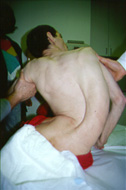

Neuromuscular scoliosis is an irregular spinal curvature caused by disorders of the brain, spinal cord, and muscular system. Nerves and muscles are unable to maintain appropriate balance / alignment of the spine and trunk. Neuromuscular curves are often associated with pelvic obliquity, a condition in which the child's pelvis is unevenly tilted with one side higher than the other. Frequently, kyphosis is also concurrently present.
Compared with idiopathic scoliosis, neuromuscular scoliosis is much more likely to produce curves that progress, and continue progressing into adulthood. (Curve progression and trunk imbalances are more severe in patients who are not able to walk).

Because of the many causes of neuromuscular scoliosis, the incidence is variable (Table 1). The likelihood and severity of the curves tends to increase with the degree of neuromuscular involvement.
| Diagnosis | Incidence of Scoliosis |
|---|---|
| Cerebral palsy (2 limbs involved) | 25% |
| Myelodysplasia (lower lumbar) | 60% |
| Spinal muscle atrophy | 67% |
| Friedreich ataxia | 80% |
| Cerebral palsy (4 limbs involved) | 80% |
| Duchenne muscular dystrophy | 90% |
| Myelodysplasia (thoracic level) | 100% |
| Traumatic paralysis (<10 years) | 100% |
Nonoperative treatment should be prescribed and managed by a multidisciplinary team to ensure that all clinical areas receiving the proper treatment: pulmonary, neurologic, genitourinary, orthopedic, nutritional and gastroenterologic. Nonoperative treatments can include the following:
The type of spinal stabilization depends on the age of the patient, ambulatory status, and underlying condition. Surgical goals are: